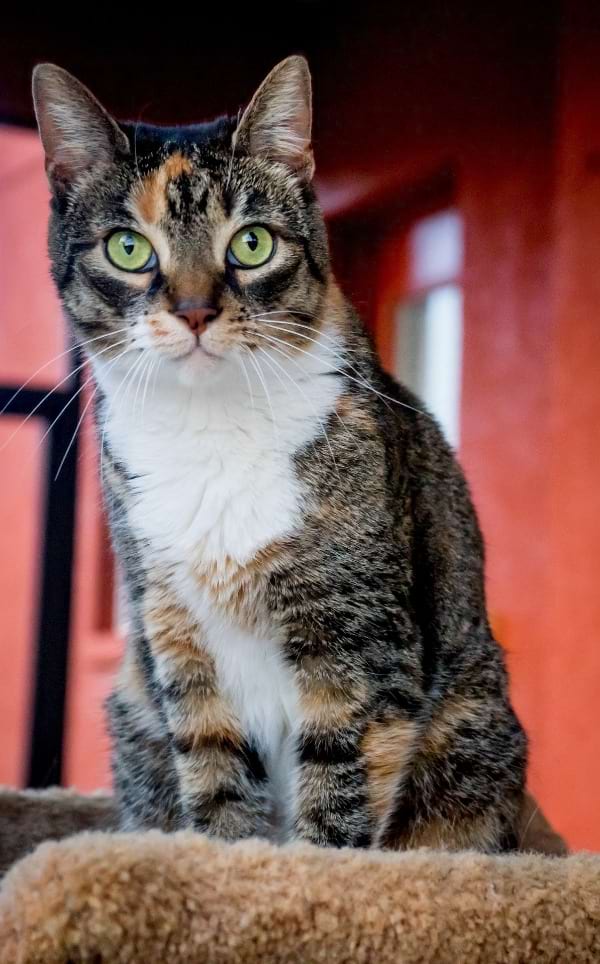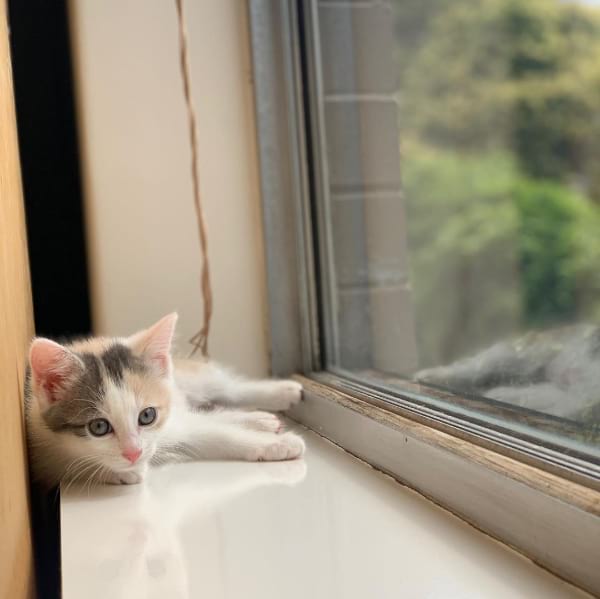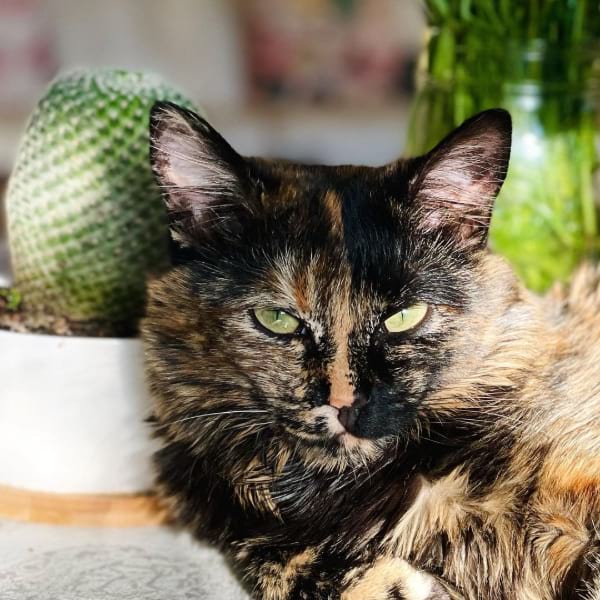If you are searching for a cat with a unique appearance, dilute calico is the best pet you have dreamt about. This is not about some special breed but the one-of-the-kind feline coloration. Calicos are notable for their rich history and perfect color patterns of their coats.
Some people only heard about these cats but have no idea about their specials and main features. Let’s take a closer look at smooth-coated and fluffy dilute calico buddies. These are beautiful pets with the exceptional appearance of unbelievable rarity.
What Is a Dilute Calico?

One of the types of calico cats is dilute ones. These are feline males and females are extremely colorful with three patterns at once when it comes to the coat coloration.
There are white, black, grey calico cat types – the main color pattern is taken into account. But the combination of feline fur coloring should contain white patches whatever it is. This is the significant feature of both smooth-coated and long-haired calico cat pets.
When it comes to dilute type, the main idea is the less intense color pattern. For example, a black dilute cat is the one with some diluted patches (blue, grey, smoky, etc.). This way the coat of felines becomes exceptionally colorful but all the colors harmonize with each other. But the dilute color pattern is very rare because of rather complicated genetics.
Some experts compare diluted calico cats with the watercolor pallet where less intense patterns are presented. It means that calico-free felines are colored in oil paints with bright patches (reddish, brown, black, orange, etc.). The rare dilute calico kitten can appear in different breeds, such as American Bobtail, Curl, Longhair, Cornish and Devon Rex, Manx, Persian, etc.
Expert’s Word about Dilute Calicos
The feline specialists state that a light calico cat is the probability of 1 for a thousand other bewhiskered ones in the breed. It means that diluted pets with their creamy or light-blue patterns are a real treasure for owners.
The rarity of the blue, nude, and white calico cat with low-intensive pets can be explained by the special dilute gene that can be met very seldom.
Nevertheless, the kitties of rare appearance are performed in many breeds. Lilac calico cats, smoky grey buddies, and even pinkish cats can be born and please owners with their extremely pretty look. Among calico breeds are the most popular ones:
- Dilute calico Maine Coon cats;
- Dilute calico Ragdoll cats;
- Dilute calico Siamese cats;
- Dilute calico Persians, etc.
Dilute Calico Cats – The Dilute Gene
It is worth mentioning that calico mix cat pets are considered rare because the feline should inherit three special genes. One of them is a mosaic that is responsible for two basic color patterns. When calico-free cats have only one coloration without this gene, calicos (including dilute calico ones) obtain both colorings (for example, grey and lilac).
Additionally, there is a white-driven gene that is responsible for a snow-white coat as the background for colorful spots on the fur. If all the required markers meet together, a dilute calico kitty appears. Note that most felines have brighter color patterns with intensive shadows (brown calico cat). Diluted ones are light colored calico cats without a deep-palette coating.
That is why calico mix cat pets and dilute buddies are not the same bewhiskered friends. Basic and dense colors of diluted ones are far from bright and dominant. This is like a nude blend of tender colors at once. As calico genetics is so complicated, many owners “hunt” kittens with the special dilute gene.
Predicting Dilute Calico Kittens

It is worth mentioning that a pastel calico cat or other types of calicos cannot be predicted accurately. These kittens are born by chance. Many breeders expect to have calico kitties from multicolor males and females. But it is just a lottery.
You can just expect some color combinations if you are pairing two calico cats. For example, a female of cream color with white patches paired with the male of blue shading and light lilac with humid intense might give the birth of a:
- Blue calico cat;
- Lilac muted calico kitten;
- A fluffy buddy of a calm reddish color (creamy).
Let’s take a closer look at the different possible color combinations that breeders use to define calico kitties (approximately).
Color Combinations
Speaking about calico cat colors, there is a huge variety of different variants to take into consideration. First, let’s review dense-colored buddies. These female and male calico cat pets are notable with the combination of the main colors.
Dense bewhiskered friends are usually of intensive black, reddish, and white color patterns. Such as a cinnamon calico cat or tortie-colored ones are seldom met. But even orange and brown dense colorations can be presented in the litter by luck.
If we take a closer look at the dilute calico pet companions, they have coats of calm color patterns. So the combinations like white + lilac + blue or white + grey + cream can be seen sometimes. Among other coloring variations are:
- White + blue + cream;
- White + lilac + cream;
- White + fawn + cream.
If you are hunting some exotic colorations like a cinnamon-colored cat, patched tabby, or tortoiseshell, you need to know the peculiarities of these color combinations to have more chances to find a pet of the required coat tint.
Tortoiseshell and Patched Tabby

Dilute calico felines can also be of some exotic coloration. For example, cream-colored cats with brown and light orange spots are often called torts. But note that there is a big difference between diluted and tortoiseshell ones. The dominance of white color is an essential appearance feature of calico buddies.
It means that the dilemma of tortoiseshell cat vs calico (a black and brown calico cat) can easily be solved with the presence of white coloring on the coat. Diluted calicos have more white spots and background shading than torts. Tortoiseshell felines obtain a little white. So many cat owners do not relate torts to calico *especially when she-cats and he-cats have bright patches that are far from dense and dilute coloration).
One of the most exotic colorations is the calico tabby color pattern. There are special stripes of soft black or dark orange on the bewhiskered pets’ bodies. These distinct features make any tabby calico cat a real treasure for real valuers of the feline coloration.
Are All Calicos Female?
Not exactly this way. The percentage of calico cat female pets is really huge (about 99.5%). This is all about special genetics. But there is a tiny chance to become an owner of the male with such an exotic coloration. Female sex chromosomes (XX) win in the context of the dense and dilute calico color pattern.
Can Dilute Calico Cats Be Male?
Meeting a male dilute calico cat is a rarity. According to the survey of Missouri’s College of Vet Medicine, the chance of the birth of a calico-friendly he-cat is 1 to 3000. These felines obtain a special chromosome set – two X and one Y. It happens very seldom. But it does not mean that a male calico cat is impossible.
Female buddies with this special coloration dominate. They also have a special genetic makeup as he-cats. Both female and male calico cat’s price is rather high. It can be explained by their rarity for sure.
Klinefelter Syndrome in Cats
Klinefelter Syndrome, also known as XXY Syndrome, is a genetic disorder that affects male calico cats. This condition is caused by an extra ‘X’ chromosome, making the cat triploid (XXY) instead of diploid (XY). Dilute calicos are more likely to have this syndrome than other cats, as the gene responsible for their coat color is situated on the X chromosome.
Klinefelter Syndrome causes a variety of physical and behavioral symptoms in affected cats. Physically, males with this condition may have decreased muscle tone and smaller than normal testicles. Behaviorally, they can be more docile and less active than other cats.
The most common symptom associated with Klinefelter Syndrome is infertility, as the condition can cause the testes to be underdeveloped and malfunctioning. As a result, male calicos are usually unable to reproduce, unless they receive medical treatment.
Dilute Calico Cat Personality
The calico cats’ behavior does not depend on their coloration. Even such rare color patterns cannot bring extra features of character to these fluffy buddies. The dilute calico personality is breed-specific.
If you are dreaming about Maine Coon with such a three-colored coating, read more about this breed to know more about its character. If you are dreaming about dilute calico British Shorthair pets, find out more about the breed-specific features of cats.
Calico Breeds
Is calico a breed? Exactly no. This is the type of rare coloration that can be met among feline representatives of different breeds. The question can be rephrased: “What breed is a calico cat?”.
There is a range of breeds that can present a gift – a dilute tortoiseshell cat, lilac calico pet, dilute calico tabby, etc. Among the most calico-friendly ones are:
- American Longhair/Shorthair cats;
- British Shorthair cats;
- Ragdolls;
- Maine Coon cats;
- Japanese cats;
- Persians;
- Manx;
- Cornish/ Devon Rex.
Can You Get Long Hair Dilute Calico Cats?
Some long-hair breeds can obtain calico cat characteristics in the context of coloration. Strawberry blond or lilac patterns are possible among Ragdolls and Birmans. Long haired dilute calicos can be born in the litters of Maine Coon, American (Bobtail), and Manx.
The list of calico-friendly long-hair buddies can be complemented by Turkish Angora bewhiskered pet companions. A Japanese calico cat usually has a long-hair coat as well. Do not forget about Persians, Norwegian Forest, and Selkirk Rex felines.
Note that short-haired calico cat pets also take place in various breeds. Among them are:
- American Shorthair calico buddies;
- Cornish Rex cats;
- Devon Rex felines;
- Dilute calico Exotic Shorthair, etc.
Frequently Asked Questions
Are Calico Cats Lucky?
There is a belief that calicos (including dilute calico cats) bring luck to the owners. By the way, any three-colored pet is considered a lucky charm. That is why many people prefer to adopt calicos. It is worth noting that the felines of calico coloration are the official symbol of fortune in Japan!
Are Dilute Calicos Nice?
They have a very attractive appearance for sure. Calicos look nice. Diluted felines are especially eye-catching for their smooth color transitioning. Both long-haired and short-haired calico cat pets are smart, curious, and playful. Other characteristics are breed-specific.
How rare is a dilute calico?
Due to their unique coloring, dilute calico cats are quite rare. It is estimated that only one in every 3,000 cats is a dilute calico. While the average litter of kittens contains around 4-5 kittens, litters with dilute calicos are even smaller, with only 1 or 2 per litter. This means that it can be exceptionally difficult to find dilute calicos, as not many are being bred. This low availability makes them even more sought-after and admired.
What’s the difference between a calico and a dilute calico?
Calicos are cats characterized by a white base coat with patches of two other colors – typically black or orange. Dilute calicos, on the other hand, are cats that have slightly different coloring patterns. Rather than having solid patches of color like traditional calicos, dilute calicos possess lighter shades of their two colors, such as grey and cream (it is also called a faded calico cat) or buff. Dilute calicos can also have patches of white in addition to the two other colors. Due to their unusual coloring patterns, dilute calicos are some of the rarest cats around – making them highly sought-after by cat fanciers.
How Big Do Dilute Calico Cats Get When Fully Grown?
Dilute calico cats are usually medium-sized cats. When fully grown, they can reach up to 8-14 inches in height and weigh between 6-10 pounds. They have muscular bodies with long legs and a broad chest.
Do Dilute Calico Cats Have Health Problems?
While dilute calico cats appear just like any other healthy feline, they are actually susceptible to a number of health issues. These cats can suffer from vision problems such as retinal atrophy, deafness and Feline Infectious Peritonitis (FIP).
Dilute calicos have also been known to experience joint problems such as hip dysplasia and be more prone to developing bladder stones. Owners should be sure to have their dilute calico checked for these potential conditions regularly by a veterinarian. Additionally, it’s important to keep them up-to-date on vaccinations, flea prevention, regular grooming and dental care in order to maintain their health.
Are Dilute Calico Cats High Maintenance? How to Groom a Dilute Calico Cat?
Dilute calico cats can be a bit more high-maintenance than other cats. They will require regular grooming and brushing to keep their fur healthy and looking its best. Here are some tips for taking care of your dilute calico cat:
- Brush your cat’s coat several times a week to remove any dirt, debris, and dead fur. This will help keep the coat looking shiny and healthy.
- Groom your cat’s fur with a quality pet shampoo that is specifically designed for cats.
- Use a mild conditioner after shampooing if you notice that your cat’s coat is dry or dull.
- Trim your cat’s nails at least once a month to prevent the nails from becoming too long and sharp.
- Check your dilute calico cat’s ears on a regular basis for any signs of wax buildup, redness, or other signs of infection. If you notice any of these symptoms, take your cat to the vet.
By taking the time to properly groom and care for your dilute calico cat, you can keep them looking their best and healthy for years to come!
Are Dilute Calico Cats Hypoallergenic?
Dilute Calico cats are not hypoallergenic and can trigger allergies in people who are sensitive to cats. It’s important to note that people with allergies should still proceed with caution when considering a dilute calico cat as a pet.
How Much Is a Dilute Calico Worth?
The felines with aesthetically muted coloration can be bought from both certified breeders and local shelters. The dilute calico cat price depends on the breed of the feline you would like to adopt.
For example, shelters and rescue centers can offer costs from $60 up to $200. At the same time, a beautiful reversed calico cat with blue eyes can be purchased from breeders at $600-$2,000. The rarer the coloration is, the higher the cost is.
Bottom Line
One of the most multicolored cats in the world is the calico. Three-colored buddies are the symbol of fortune and a good pet companion with an eye-catching appearance.
There are many variations of color patterns to take into account. Calicos are often compared with other felines of exotic coloration like a cinnamon tortie cat (or chocolate tortoiseshell cat). But neither torts nor tabby have such intense-free color patterns as dilute calico bewhiskered buddies.
It is more likely that your calico kitten will be a female because fluffy ladies dominate. Males with such rare coloration are extremely sterile because of their unique gene makeup (XXY). It is worth noting that dilute calico felines can be met in different breeds, including Maine Coon, Ragdoll, Persian, Manx, etc.
The post Shocking Facts About Dilute Calico Cats appeared first on CatsPurfection.
